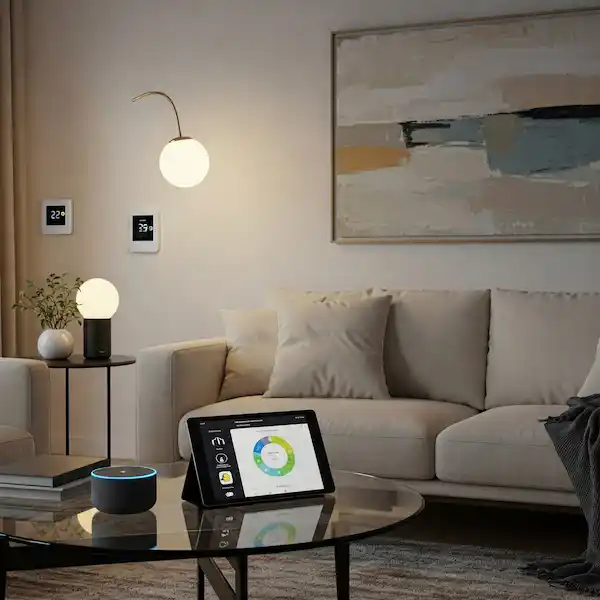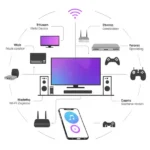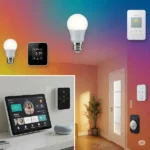Your Guide to Building a Smart Home: Convenience, Efficiency, and Security
Imagine a home that anticipates your needs – lights turning on as you enter a room, the thermostat adjusting automatically based on the weather, or receiving alerts if a door is unexpectedly opened. This isn’t science fiction; it’s the reality of a smart home. Setting up a smart home might seem daunting, but it’s a step-by-step process that can significantly enhance your comfort, security, and even save you money.
What is a Smart Home?
A smart home connects various devices and appliances to a central network, often controlled via a smartphone app, voice assistant, or automated schedules. These devices can communicate with each other and respond to your commands or predefined conditions, making your home more automated and responsive.
How to Set Up Your Smart Home
Setting up a smart home doesn’t require you to convert your entire house overnight. You can start small and expand gradually. Here’s a basic approach:
- Identify Your Goals: What do you want your smart home to do? Are you focused on saving energy, improving security, increasing convenience, or all of the above? Your goals will help you choose the right devices.
- Choose Your Platform/Ecosystem: Many smart devices are designed to work within specific ecosystems. Popular options include:
- Apple HomeKit: Tightly integrated with Apple devices.
- Google Home/Google Assistant: Works well with Android and Google services.
- Amazon Alexa: Compatible with a vast range of devices.
- Samsung SmartThings: A more open platform supporting various protocols. Choosing an ecosystem can simplify compatibility, though many devices now support multiple platforms.
- Establish a Reliable Network: A strong and stable Wi-Fi network is crucial. Consider upgrading your router if it’s old or you have a large home. Some devices also use other protocols like Zigbee or Z-Wave, which often require a hub connected to your network.
- Start with a Few Devices: Don’t try to automate everything at once. Begin with a few key devices that address your primary goals (more on which ones below).
- Install and Configure: Follow the manufacturer’s instructions to install each device and connect it to your network and chosen platform. This usually involves downloading an app and pairing the device.
- Explore Automation and Routines: Once devices are connected, explore creating automation rules (e.g., turn lights off when the last person leaves) or routines (e.g., say “Good Morning” to turn on lights and play news).
- Expand Gradually: As you get comfortable, add more devices and integrate them into your existing setup.
Examples of Smart Home Device Providers
The market is flooded with smart home devices. Some prominent providers include:
- Amazon (Echo devices, Ring doorbells/cameras): Strong in voice assistants and security.
- Google (Nest thermostats, cameras, displays): Known for thermostats and displays.
- Philips Hue: A leader in smart lighting.
- TP-Link (Kasa Smart and Tapo): Offers a wide range of affordable smart plugs, bulbs, and cameras.
- Wyze: Known for budget-friendly cameras and other small devices.
- Arlo: Specializes in wireless security cameras.
- Ecobee: Popular for smart thermostats with remote sensors.
- Schlage/Yale: Provide smart locks.
- Sonos: High-quality multi-room smart speakers.
Many other companies also make devices compatible with major ecosystems.
Pros and Cons of a Smart Home
Pros:
- Convenience: Control devices from anywhere, automate tasks, and use voice commands.
- Energy Efficiency: Smart thermostats and lighting can optimize usage, potentially lowering bills.
- Increased Security: Smart locks, cameras, and sensors can monitor your home and alert you to issues.
- Enhanced Comfort: Adjust lighting, temperature, and entertainment effortlessly.
- Accessibility: Can assist individuals with mobility challenges.
Cons:
- Cost: Initial setup can be expensive, especially when starting with multiple devices.
- Complexity: Setting up and troubleshooting can sometimes be challenging.
- Security Risks: Like any connected technology, smart devices can be vulnerable to hacking if not properly secured.
- Privacy Concerns: Devices with microphones or cameras collect data, raising privacy questions.
- Reliability: Dependence on Wi-Fi and power means devices may not function during outages.
- Compatibility Issues: Ensuring devices work together smoothly across different brands and platforms can be tricky.
Which Smart Home Devices Should You Add First for Savings or Benefits?
If you’re looking to dip your toes into smart home technology and see tangible benefits quickly, consider starting with these devices:
- Smart Thermostat: This is often cited as having the best potential for energy savings. A smart thermostat learns your habits, adjusts temperature based on occupancy or schedules, and can be controlled remotely. This prevents heating or cooling an empty house and optimizes energy usage. Examples: Google Nest, Ecobee. Smart Thermostats and Climate Control
- Smart Plugs: These affordable devices plug into existing outlets and turn any plugged-in appliance (lamps, fans, coffee makers) into a smart device controllable via app or voice. They are great for turning off “vampire” energy draw from electronics and automating simple tasks. Examples: TP-Link Kasa, Wyze.
- Smart Bulbs: While slightly more expensive than traditional bulbs, smart LED bulbs are energy-efficient and offer control over brightness and color temperature. Automating lights can prevent leaving them on unnecessarily, contributing to energy savings and convenience. Examples: Philips Hue, TP-Link Tapo, Wyze.
- Smart Video Doorbell: While not directly saving money on utilities, a video doorbell significantly enhances security. You can see and speak to visitors from anywhere, deter package theft, and monitor activity around your front door, providing peace of mind. Examples: Ring, Google Nest Doorbell, Arlo.
Starting with one or two of these devices allows you to experience the benefits of a smart home firsthand, understand how the technology works, and then decide where you want to expand your smart home journey.
Setting up a smart home is an evolving process. By starting with clear goals and a few impactful devices, you can gradually build a connected home that offers enhanced convenience, security, and efficiency tailored to your lifestyle.
Additional helpful information
More about smart home appliances – Smart Home Appliances
Set up a home media network – Monitor and Control Your Media Smart Home
Some details about the various smart home ecosystems – Smart Home Ecosystems: HomeKit vs. Google Home vs. Alexa




